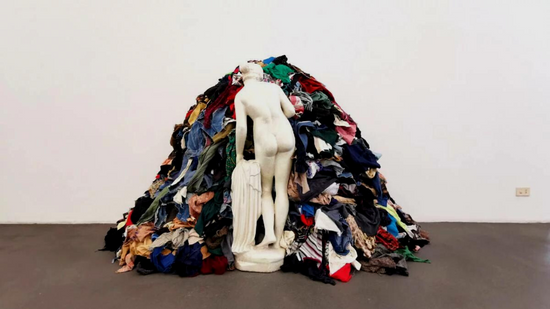
What was the Arte Povera movement?
Arte povera was a radical Italian artistic movement, from the late 1960s to the 1970s, whose artists explored a range of unconventional processes with 'everyday' materials. Arte povera emerged within a network of urban cultural activity in these cities as Italy was gripped by economic instability once again. The main artists of this movement were Giovanni Anselmo, Alighiero Boetti, Pier Paolo Calzolari, Luciano Fabro, Piero Gilardi, Jannis Kounellis, Mario Merz, Marisa Merz, Giulio Paolini, Pino Pascali, Giuseppe Penone, Michelangelo Pistoletto, Emilio Prini and Gilberto Zorio, being that these worked in many different ways. They painted, sculpted, photographed, created works of great physical presence and small-scale gestures, in addition to performances and installations. Find out more about this artistic movement here.

What was Arte Povera? Where did it come from?
Arte Povera - the Italian expression for "poor art" or "impoverished art" - was one of the most significant and influential avant-garde movements to emerge in southern Europe in the late 1960s. Arte povera literally means 'poor art', but the word poor here refers to the unique exploration of movement in a wide range of materials beyond traditional oil paint on canvas, bronze or carved marble. It included the work of a dozen or so Italian artists whose most distinctively recognizable characteristic was their use of common materials that evoked a pre-industrial era, such as earth, stone, clothing, paper and rope: literally 'poor' or cheap materials that artists reused for their practice. Undoubtedly, the construction of art pieces with disposable materials was also a way for artists to challenge and break the values of the commercial art system. These works challenged established notions of value and property, as well as subtly criticizing the industrialization and mechanization of Italy at the time.
Why is it called Arte Povera?
The term was introduced by the Italian art critic and curator Germano Celant in 1967, who referred to arte povera as poor, not for lack of money, but rather for creating art without the constraints of traditional practices and materials. His pioneering texts and a series of important exhibitions provided a collective identity for many young Italian artists based in Turin, Milan, Genoa and Rome.
Germano Celant regularly placed Arte Povera in his studies in dialogue with other artistic movements of the 1950s and 1960s. The art critic mentioned that Arte Povera's interest in "poor" materials was related to Fluxus and Nouveau Réalisme, for both combine easily accessible materials and remove their usual function.

Is Arte Povera Conceptual Art? Is Arte Povera Assemblage?
Arte Povera turned out to be often related to Assemblage, an international trend that uses similar materials. Both movements marked a reaction against abstract painting, the dominant art of the period. Abstract art was seen as concerned with emotion and individual expression, and too confined to the traditions of painting. In contrast, Arte Povera, was an artistic practice much more interested in materiality and physicality and borrowed forms and materials from everyday life. Arte Povera can be distinguished from Assemblage by its interest in performance and installation, approaches common in pre-war avant-gardes such as Surrealism, Dadaism and Constructivism.

What is the artistic medium most associated with Arte Povera?
Sculpture is the artistic medium most associated with Arte Povera. Partly due to artists' rejection of abstract and minimalist painting, which dominated the international art market in the 1960s. Giovanni Anselmo's Untitled (1968), which mandated that the gallery continually replace the lettuce in the center of the sculpture to maintain its integrity, or Michelangelo Pistoletto's Minus Objects series, which required the viewer to engage and/or manipulate the object to extract its meaning, literally filling the void or 'negative space' of the sculpture. In this movement, artists also tried to unite the natural and the artificial, or at least draw attention to this distinction. This can be seen most clearly in the choice and display of materials, with works where, for example, water and earth can be constrained by frames or geometric structures.

The Influence of Arte Povera: Why is Arte Povera still important?
This movement marked a reaction against the modernist abstract painting that dominated European art in the 1950s. These artists distinguished themselves from the previous current by focusing on sculptural work rather than painting. However, the group also rejected American minimalism. The heyday of the movement was from 1967 to 1972, but its influence on art has endured.
Despite growing popularity, the movement dissolved by the mid-1970s, as artists' individual styles continued to grow in different directions. Their brief unity, and Celant's ability to articulate the movement's concerns, had already left an imprint on art history, although its importance was not fully recognized until decades later. After the reassessment of the 1960s that took place in the early 21st century, critics are now deliberately paying more attention to movements outside the United States in the period. As a result of this research and critical shift, Arte Povera experienced something of a renaissance within academia. The movement has also been cited as a precursor to some more recent approaches to sculptural practice, including Young British Artists (YBA Gavin Turk cites Manzoni as a key influence, as he was on Arte Povera).
